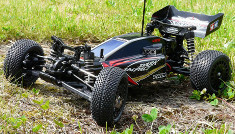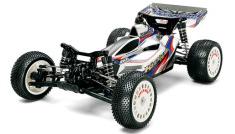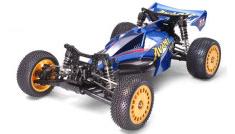The DF platform
The name of this chassis series means Dirt Four Wheel-Drive, but DF-01 received its name later on.
The first generation of this chassis is very important in Tamiya history because it gave birth to the On-Road TA platform. It is also important for itself, since it started back in 1990 and, so far, was used up to 2009.
DF-01 chassis
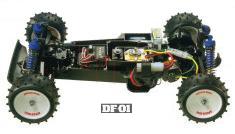
DF-02 chassis
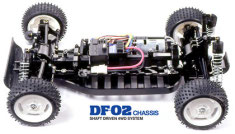
DF-03 chassis
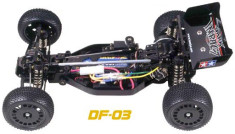
DF-03Ra chassis
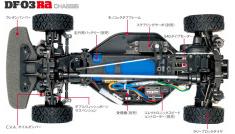
58087 Manta Ray (1990)
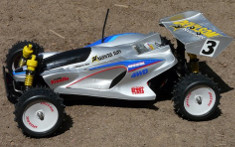
58334 Rising Storm (2004)
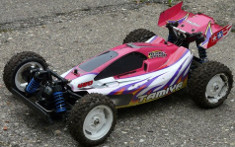
58370 Dark Impact (2006)
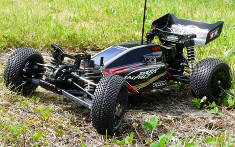
58417 Subaru Impreza WRC (2008)
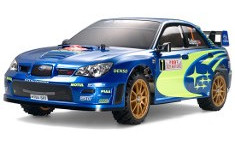
The DF-01 is Tamiya's 4th generation of 4WD buggies. However, despite being an entirely new design made for leisure-oriented usage, it received two racing versions with the Top Force (Tamiya's 100th model) and the heavily hopped-up 58107 Top Force Evolution. Here are 4 of the most representative models using the DF-01 chassis:
58087 Manta Ray (1990)
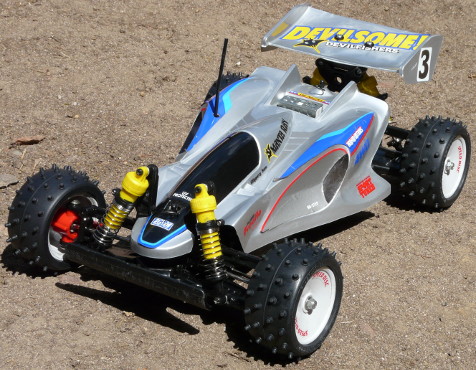
58100 Top Force (1991)
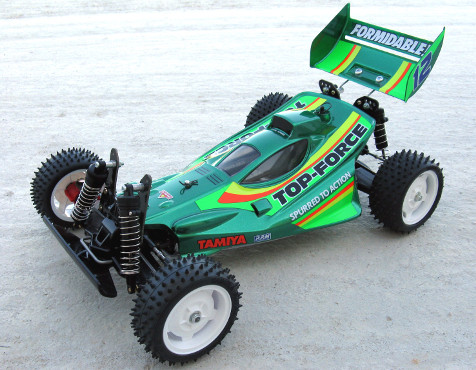
58107 Top Force Evolution (1992)
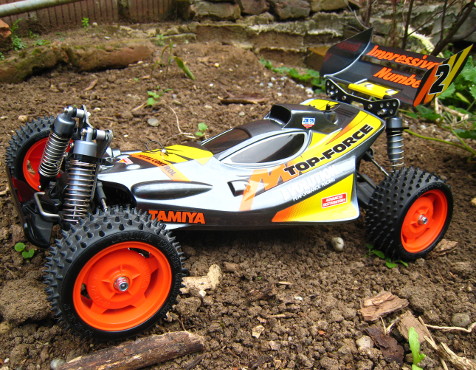
58115 Terra Conqueror (1992)
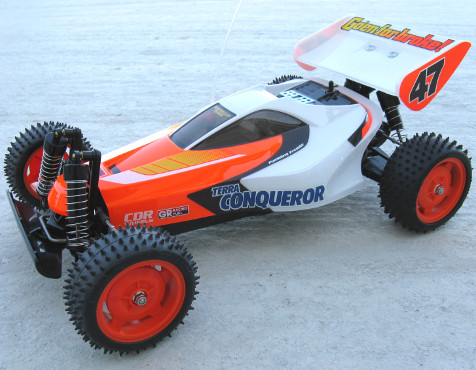
The DF-01 was often used in club races at the time, in particular the Top Force and Evo models that offered more options to setup and stronger FRP damper stays. But the DF-01 was meant for leisure-oriented usage and it was never raced at international levels. Apart from its commercial success at the time, the DF-01 main asset was versatility, a feature Tamiya used a lot: not less than 4 more or less direct variants derived from this chassis, one of them bringing a major change in RC history.
The first and most important is the TA-01 Touring variant: by transforming the DF-01 buggy chassis into the TA-01 (and TA-02) Touring chassis, Tamiya literally made history and offered a major evolution to the RC world at the beginning of the 90's. Indeed, so far buggies were ruling the RC world since the mid-80's, Tamiya themselves being an active participant to the buggy golden era. But in 1991, RC changed when Tamiya presented the TA-01 chassis: the general public massively forgot about buggies and focused on On-Road models.
DF-01 chassis
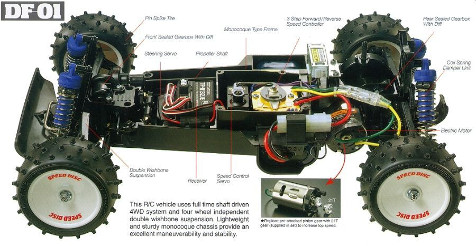
TA-01 chassis
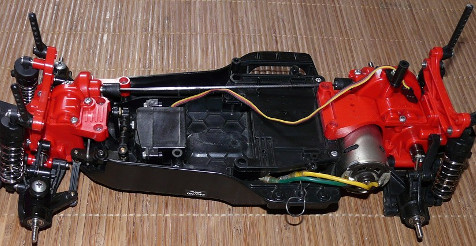
The DF-01 chassis was offered two more variants: however, these variants were quite confusing for those of use who like to understand the chassis, especially when trying to identify common parts with other models. And Tamiya made it difficult to help fans on this matter, but Tamiya subsidiaries got confused too ![]()
Comfortably sit on your chair, we are going to make things clearer. To get it right, let's have a closer look to the TA-01 and TA-02 chassis first, before we explain the two DF-01 variants:
TA-01 chassis
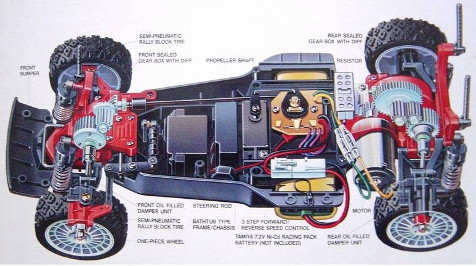
TA-02 chassis
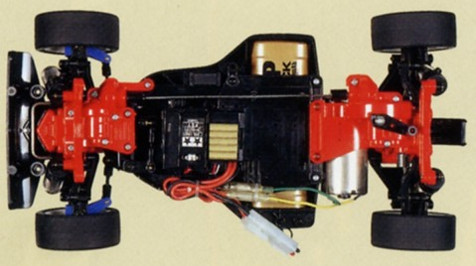
DF-01 "CC" chassis
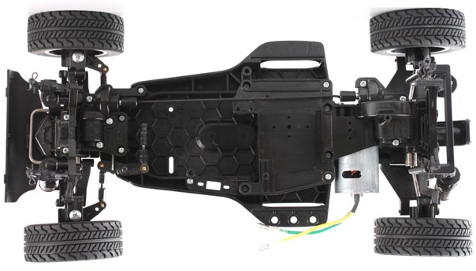
TA-02T chassis
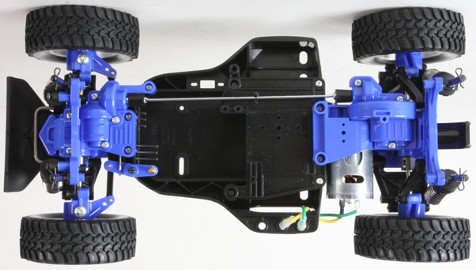
So, the two main differences between a TA-01 and a TA-02: the TA-02 bathtub is slightly shorter and does not have the TA-01 “honeycomb” design inside the bathtub.
The FD-01 “CC” does not officially exists: Tamiya (Japan) names it DF-01. Period. Except it is not a true DF-01 (it is not a buggy chassis with long arms). The DF-01 “CC”, for Cross-Country as I chose to call it, is a TA-01 bathtub chassis using specific arms that only the rare and specific models of this series use.
The TA-02T chassis only received its official naming in 2011: before that, it has no official name and people generally called it “TA-01 / TA-02 mix”. Because the TA-02T is just that: the TA-02 bathtub chassis using TA-01 arms (flipped at the rear in order to modify the overall wheelbase).
These details prove the DF-01 versatile design and got people confused when trying to precisely identify the chassis a model used. But actually, the confusion spread up to some of Tamiya subsidiaries since Tamiya USA identifies the 58154 M1025 Hummer and 58326 Light Armored Vehicle models as TA-01 / TA-02 based (which became TA-02T) when they do use the DF-01 (“CC” variant) instead.
In order of appearance, the first of these variants was the one initially called TA-01 / TA-02, a name Tamiya never officially used before the chassis was finally first named TA-02T in 2011:
58136 Toyota Prerunner (1994)
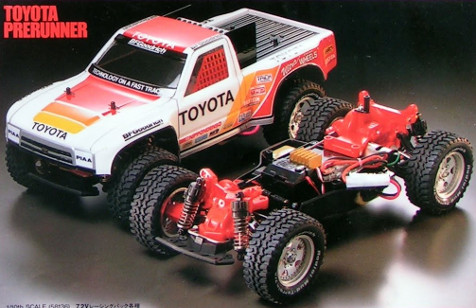
58146 Chevy S-10 (1994)
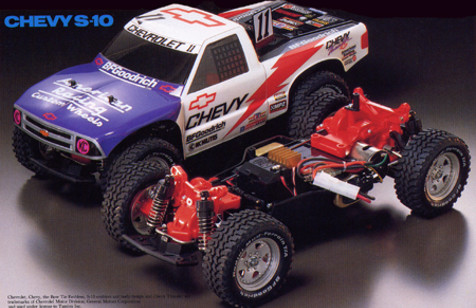
58161 Ford F-150 (1995)
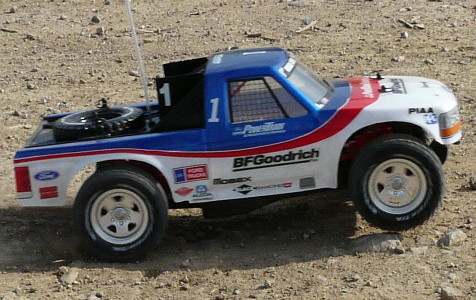
58537 Desert Fielder (2012)
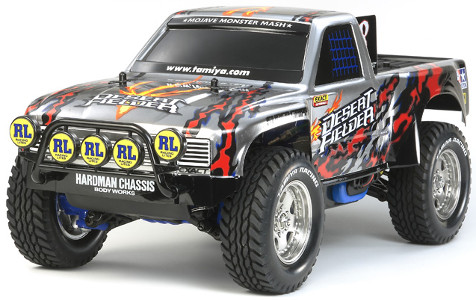
All the models using this variant are “Baja” Trucks, the “civilized” ancestors of what we now call Short Course Trucks. Of course, both today and at the time (since the chassis is identical), these models can't compete with modern Short Course Trucks since the size is different (the Slash is close to twice as big as any of the above model). But still, these models are great to run on slippery flat surfaces: they are not very good at jumping, but they easily power slide in dust. At the time, they were not very successful models, even though the Ford F-150 remained available in Germany up to year 2010. As of today, it is still a bit too soon to determine if the 2011 releases sell well.
The second variant I called DF-01 “CC” was not much used by Tamiya, but the two first models sold pretty well to scale trail fans because of their highly detailed ABS bodyshells:
58154 M1025 Hummer (1995)
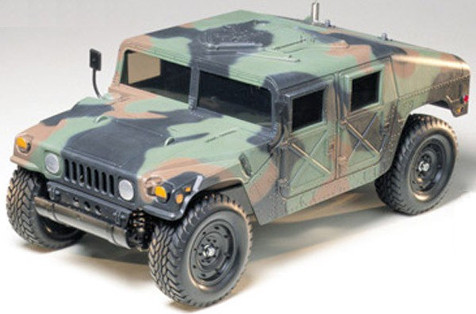
58326 JGSDF Light Armored Vehicle (2004)
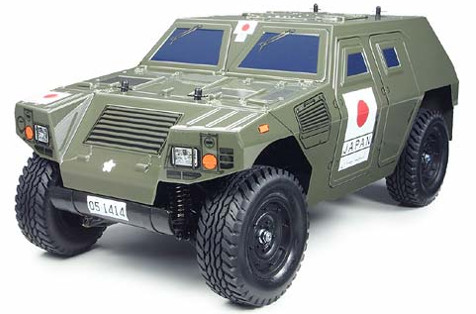
58406 Cayenne S Transsyberia 2007 (2008)
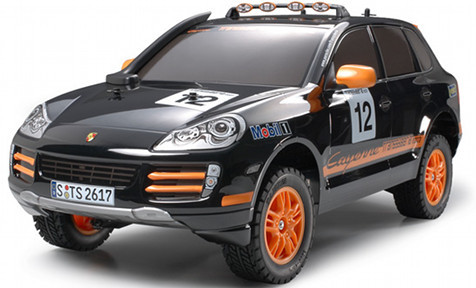
58421 Team Repsol Mitsubishi Lancer (2009)
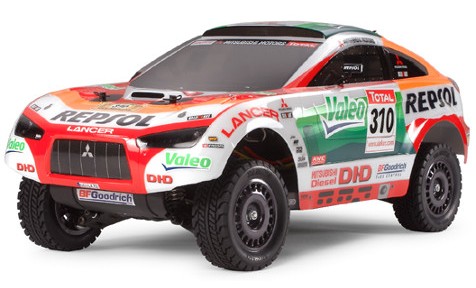
The two first models of this series were the most attractive of the series, especially in Europe and USA for the first model, the Japanese military vehicle being pretty much unknown in these countries. Scale trailing was a diversion for these models since the chassis did not perform very well in this category and the heavy ABS bodyshells imply a higher center of gravity. Nonetheless, they were highly scale-realistic so many fans tried them in that purpose. It is difficult to say whether they sold well or not: in Europe, they could mostly be found in XB Pro versions.
The DF-01 buggy evolution only came by 2004 with the DF-02, which is the buggy equivalent of the On-Road TT-01 chassis.
DF-02 chassis (2004)
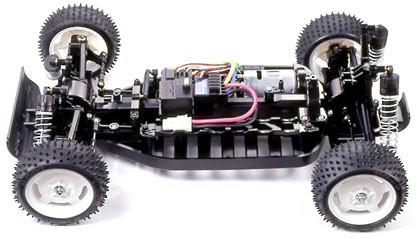
TT-01 chassis (2003)
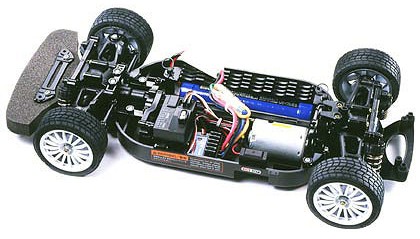
58328 Gravel Hound (2004)
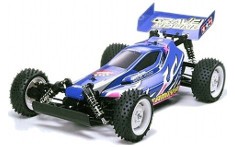
58334 Rising Storm (2004)

58399 Plasma Edge (2007)
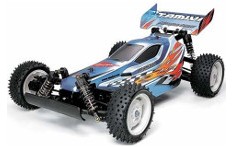
58550 Aero Avante (2012)
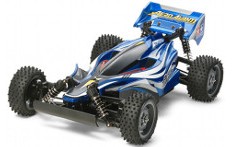
Despite the chassis layout being reversed, (steering / motor and battery locations), and the slightly altered bathtub form, you can find all the TT-01 genes in this chassis. It is worth to mention that Tamiya never linked these two chassis together, but the lack of any TT-01 variant and similarities with the DF-02 speak for themselves. Only 4 models use this chassis, which commercial success does not seem to have been of great amplitude, and the resurgence of the Aero Avante in 2012 still remains an interrogation.
With time, the DF-02 revealed to be a good leisure-oriented chassis, very reliable and solid: apart from a quite low ground clearance for a buggy, one can't complain much about it for such a low price. Still, comparing it to the DF-01 it had to renew, despite some weaknesses on the DF-01, there is something missing on this second generation. Maybe a dose of charm.
The DF-03 is the last current generation of the platform. More modern and highly priced than the DF-02, the buggy variant never seemed to sell well. However, the rally variant was pretty successful on the rally niche of market.
DF-03Ra chassis
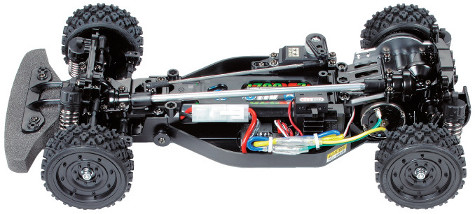
58417 Subaru Impreza WRC '07 (2008)
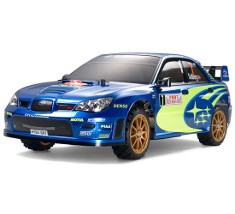
58430 Subaru Impreza WRC '08 (2009)
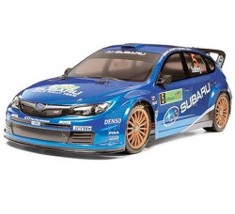
58440 Mitsubishi Lancer Evo X (2009)
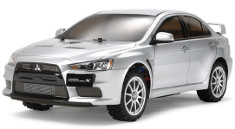
58446 Lancia Delta HF Integrale (2009)
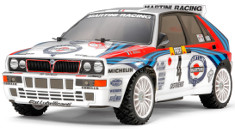
58459 Datsun 240Z Rally (2009)
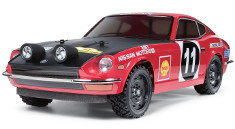
58461 Mitsubishi Lancer Evo V (2010)
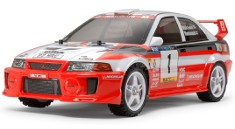
The number of models using the rally variant may be a clue on how successful the buggy variant was (not). One thing for sure, the Avante Mk.II was a fail in Europe and USA: indeed, many people thought it was a misuse of the iconic Avante name, some kind of modernized re-release that was not appreciated. In fact, this model is meant to be a “bridge” between Tamiya's RC and Mini 4WD series, in which the Avante is one very successful model, just like the Aero Avante we saw just before on the DF-02 chassis.
Conclusion on the DF platform
This extremely important platform for Tamiya gave birth to the TA platform that changed RC history at the beginning of the 90's, giving Tamiya the absolute leadership in this category, at least on the entry-mid level segments. Paradoxically, the DF-01 was still a commercial success despite the starting Touring craze it indirectly gave birth to, but the next DF buggy generations remained pretty confidential. The DF-02 is at best some sort of ghost into Tamiya offering, at the far opposite of its cousin TT-01 tremendous success. As for the DF-03 buggy, its success seemed to only rely on its rally variant.
This situation is quite odd actually: the DF-01 both had success and flipped the entire RC business by giving birth to the Touring category. But since, the next DF generations failed to meet their public, a trend that the next platforms we will review will confirm. This situation seems to only impact the 4WD buggies as the 2WD buggies, either DT-02, the Grasshopper family re-releases and the WR-02 based models are very successful.
It is not certain a DF-04 buggy shows someday in the future given the current situation and the fact that there haven't been any new DF-03 based buggy since 2007.. However, the last DF-01 based buggy was the 1997 Blazing Star which was released about 7 years before the first DF-02. So Tamiya may still have time to prepare a DF-04, perhaps as successful as the DF-01 used to be.
Related articles:




